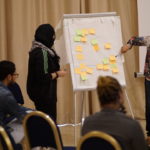Local Reconciliations in Libya: A Precarious Balance Sheet
 Local reconciliation is defined as a social process that reflects collective efforts at the local community level.
Local reconciliation is defined as a social process that reflects collective efforts at the local community level.Illustration by Othman Selmi
Local reconciliation is defined as a social process that reflects collective efforts at the local community level. It includes the processes, initiatives, and activities of interest to communities involved in conflict, aimed at reaching settlements agreed upon by the parties in conflict.[1]
Local reconciliations in Libya are one of the most prominent conflict-solving mechanisms at the local level, contributing significantly to the alleviation of conflicts during different historical periods. They played a big role after the fall of the Gaddafi regime in 2011 that left an institutional and security vacuum where tribes and their traditional leaders managed to substitute these institutions.
Local reconciliations that are based on traditional mechanisms, like customs, are among the most prominent tools for settling conflicts at the local level in Libya. These conflicts have often been tribal, territorial, murder-related, or social, such as marriage and divorce. However, after 2011, most of these conflicts were politicized and rekindled as a result of the political divisions that emerged after the classification of cities and tribes into pro-Gaddafi regime and others supporting the February Revolution. These armed conflicts resulted in social schism and displacement that plagued many areas. Perhaps the most prominent example of this is the Misrata-Tawergha case, where the armed conflict and its repercussion after 2011 led to the displacement of the citizens of Tawergha to various areas in Libya. The Misrata-Tawergha issue is one of the most important reconciliation files in Libya. Resolving it would support the process of community and national reconciliation in general.[2]
An Evaluation of Local Reconciliation Agreements Since 2011
Since 2011, local reconciliations of any conflict have taken on a traditional character, carried out through committees formed by tribal sheikhs in the region or proposed by tribes outside of it. Civil society activists are sometimes invited to take part in the reconciliation processes. Conditions and mechanisms are usually set in order to initiate the settlement of disputes at the local level. The results of such settlements often take the form of crisis management rather than genuine reconciliation between the conflicting parties. These initiatives seek to end the violence, cease fire between the conflicting parties, and exchange prisoners and the wounded. They are often temporary demands by all parties. In general, many of these agreements are breached and problems soon begin to arise again between the conflicting parties because the solutions were not radical and no guarantees were made for peace to continue between parties.
The most prominent local reconciliation agreement since 2011 has been the document drawn up by the Obeidat tribe on the killing of the Libyan army chief of staff and two of his comrades who were kidnapped by extremist groups. This happened after the public prosecutor summoned the former for interrogation at the behest of Chairman of the National Transitional Council Mustafa Abdul Jalil.
Table 1. Types of Agreements and Concerned Parties
|
Document |
Type of Agreement |
Parties Concerned |
Location |
Sponsor |
|
Document of the Obeidat tribe on the assassination of Major General Abdel Fattah Younis – July 2011. |
Statement |
Obeidat tribe |
Benghazi |
The tribe and a general tribal support |
|
The Transitional National Council and Tuareg Tribes agreement – November 2011. |
Agreement |
The Transitional National Council – Tuareg Tribes |
Ghadames |
Libyan Army Chief of Staff |
|
Tuareg and Toubou – December 2014 |
Agreement |
Tuareg – Toubou |
Sabha |
The Social Council of the Tribes of Werfla – Bani Walid and the South |
|
Tuareg and Toubou tribes peace and reconciliation agreement – 2015 |
Agreement |
Tuareg – Toubou |
Doha |
Governorate of Qatar |
|
Agreement on peaceful coexistence between the tribes of Qadhadhfa and Awlad Suleiman – 2016 |
Agreement |
The tribes of Qadhadhfa and Awlad Suleiman |
Sabha |
Zintan tribes, and Tarhuna, and Souq al Jum’aa |
|
Toubou and Awlad Suleiman tribes – 2017 |
Agreement |
The tribes of Qadhadhfa and Awlad Suleiman |
Sabha |
Zintan tribes, and Tarhuna, and Souq al Jum’aa |
|
Toubou and Awlad Suleiman tribes – 2017 |
Agreement |
Toubou and Awlad Suleiman
|
Rome |
The Italian Government |
|
Misrata and Tawergha Agreement – 2016 |
Agreement |
Misrata and Tawergha |
Tunis |
The United Nations Support Mission in Libya and the Presidential Council |
|
Peace Treaty between Misrata and Tawergha – 2018. |
Peace Treaty |
Misrata and Tawergha |
Misrata |
Misrata Municipal Council, Tawergha Local Council, The United Nations, and some municipal councils in Libya |
Source: Table prepared by author, 2018.
Other prominent agreements include the National Transitional Council Convention with the Tuareg tribes (2011), the Toubou and Tuareg agreement (2014), the Toubou and Tuareg agreement for Peace and Reconciliation (2015), the Agreement on cooperation and peaceful coexistence between the Qadhadfa and Awlad Suleiman tribes (2016), the reconciliation agreement between the Toubou and Awlad Suleiman tribes (2017), the Misrata-Tawergha agreement on the return of the displaced and the compensation of victims (2016), and the peace treaty between Misrata and Tawergha (2018).[3]
Through a general evaluation of the reconciliation agreements and an analysis of its terms, the following observations can be made:
-
Most agreements involved a comprehensive and lasting reconciliation between the two parties without placing mechanisms and means to achieve this.
-
In cases where there was international involvement in the reconciliation processes, reference was made to the issue of “reparation” and compensation. The agreements generally stipulated that the external mediator (namely Italy and Qatar) shall pay the amount of compensation to the affected parties. In the Libyan-sponsored agreements, the reparation and damages were not mentioned except for the Misrata-Tawergha agreement and the peace treaty between the two cities in June 2018, which emphasized the commitment of executive authorities in the Libyan state to implement the conditions of the agreement signed between the two parties.[4]
-
Therefore, many of these agreements were not successful in the implementation of their provisions. The most prominent example of this is the Misrata-Tawergha agreement which has several standing obstacles that hinder its implementation. These obstacles include the security situation which impede the provision of services in the city.[5]
-
Absence of strong state institutions and political will is the main reason for the failure of many of these agreements on the ground, especially since the implementation of measures like reparation and accountability in particular requires the support of the state.
Challenges to the Local Reconciliation Process
There are a number of challenges facing reconciliation at the local level in particular and the national level in general. Among these challenges are the spread of weapons, armed groups, and institutions that are parallel to state security institutions, obstructing any reconciliation agreements. A lack of the state’s role, particularly the security aspect, is one of the most important challenges of the reconciliation projects because the existence of the state and its institutions ensure adherence to the provisions of these agreements and contribute to their implementation. In addition, putting self interests – whether tribal or regional – before the national interest is another challenge. Interference by external parties, especially if the objectives do not serve the reconciliation file in Libya, is one of the most important challenges. There is also the phenomenon of taking the law into one’s own hands, and the absence of a culture of tolerance and reconciliation in some regions and cities. A lack of material resources that help parties who contribute to the reconciliation processes to communicate and the lack of logistical aspects are also among such challenges.
Guarantees for the Success of Local Reconciliations
To ensure the success of local reconciliations in Libya, emphasis should be placed on moral and ethical aspects, including religious restraint, loyalty to the homeland, respecting covenants, trust among parties, and the genuine desire for peace. There should also be a focus on the importance of the state’s role and its institutions in ensuring a successful implementation of various reconciliation initiatives, especially with regard to redress and accountability procedures. Among the most important guarantees of success is the role that national dialogue can play in promoting reconciliation at the local and national levels. There should be an emphasis on the independence of the parties from any external interference or attempts to politicize the file, while ensuring that national interests prevail over personal, regional, and tribal interests. In addition to this, there should be Libyan ownership of reconciliation projects, both local and national, and reconciliation meetings should be held in Libya. Other guarantees are disarmament and non-proliferation of weapons, while focusing on promoting a culture of tolerance and acceptance of the other, through education and information programs.[6]
Conclusion
Since 2011, local reconciliation efforts in Libya have mostly adopted traditional reconciliation mechanisms. Customary solution to conflict has played a major role. Tribal groups have also contributed to the settlement of disputes through the formation of reconciliation committees consisting mostly of traditional leaders. The reasons for accepting these traditional mechanisms include the local community’s acceptance of these traditional mechanisms and commitment to customs and the resulting settlements. The state’s weakness since 2011 and the absence of its various institutions, especially security and judicial establishments in many parts of the country, have enhanced the traditional role of tribes and their emerging institutions, such as tribal councils at the local, regional and national levels. One of the most prominent weakness of the local reconciliation processes is the absence of women from these processes. In fact, it is socially unacceptable for women to attend meetings, consultations, negotiations or reconciliation activities, which are seen as tasks for men only. Similarly, the youth are absent from local reconciliations as they are often seen as the source of conflict between tribes and families. Moreover, reconciliation councils often rely on decision-makers who are the senior sheikhs. It is therefore important to engage the youth and women in the community and national reconciliation initiatives, and to recognize their role in promoting security and social peace. It is also important to establish reconciliation committees of young people and women to improve their capacities to participate in such endeavors, including mediation and peace-building skills.
- Amal Obeidi is an Associate Professor in the Department of Political Science, Faculty of Economics, Benghazi University. Visiting Professor of Bayreuth University, Germany.
Keywords: Libya, reconciliation, Misrata-Tawergha
______________________________________________________________________
[1] Amal Obeidi, Local Reconciliation in Libya: An Exploratory Study on Traditional Reconciliation Process and Mechanisms since 2011, UNDP, 2018.
[2] According to the general census of the population in Libya in 2006, the Tawergha population was about 24,223, where Tawergha was part of the city of Misrata, among 25 major people’s congresses according to the administrative division during the period of Gaddafi rule. http://bsc.ly/?P=5&sec_Id=17&dep_Id=6. file:///C:/Users/bt304480/AppData/Local/Temp/7zOCD42E155/population.pdf.
According to UNHCR reports, 35,000 Tawergha refugees have been displaced to various locations throughout Libya, of whom 16,000 are in the Eastern Province and 12,000 in the Western Region, particularly in Tripoli. See also:
Libya from Repression to Revolution: A Record of Armed Conflict and International Law Violation, 2011-2013, M. Cherif Bassiuni, (ed.), Liden: Martinus Nijhoff Publishers (2013), pp. 617-619.
[3] Amal Obeidi, “Local Reconciliation in Libya: An Exploratory Study on Traditional Reconciliation Process and Mechanisms since 2011”, op.cit., pp. 9-14.
[4] Document of the Misrata Peace Treaty – Tawergha, Misrata, 3 June 2018.
[5] The security situation is one of the most important obstacles impeding the return and stability of the people of Tawergha city which still lacks the basic requirements of life. Therefore, activating the security services and facilitating the procedures of searching for the missing are considered the most important conditions for the return of citizens, not to mention rehabilitating the city and providing the necessary services such as electricity and the maintenance of schools. Source: http://alwasat.ly/news/libya/209418. 17 June 2018.
[6] This section and some parts of this article were based on interviews with some sheikhs and persons concerned with national and local reconciliation issues in Libya.




Leave a Reply
Want to join the discussion?Feel free to contribute!